WW2 U.S. Medical Replacement Training Centers (MRTC)
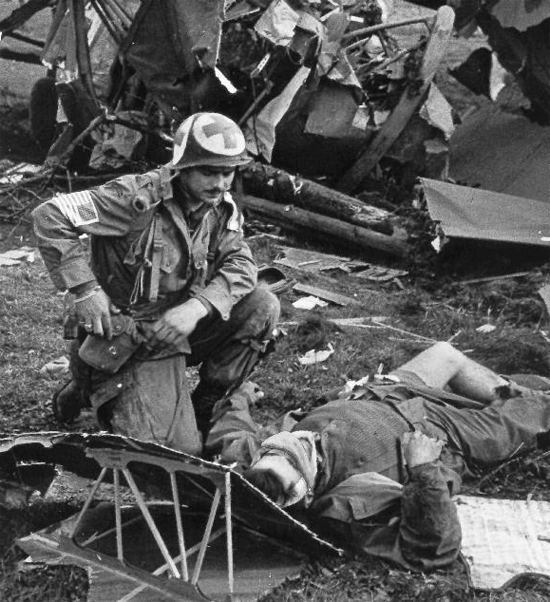
Operation “Varsity”, Germany 24 March 1945, an injured pilot is being treated by a 17th A/B Division Medic amidst his glider wreckage.
Background Information:
The ultimate purpose of all Military Training is the assurance of Victory in war! An Army must be trained to do its job in the most effective manner if it is to reach victory with the least possible losses to the country. The effectiveness of an ‘Arm’ or ‘Service’ will depend upon the degree of its training. Attached medical personnel and Medical Department units must be prepared to support the offensive spirit and actions of the Armed Forces. This is true, not only for such organizations as Medical Regiments, Medical Battalions, and Medical Detachments attached to subordinate units of the Arms and Services, but also for all medical establishments extending from the combat zone into the Zone of Interior! Units must be trained to function effectively in any type of military operation. The well-trained medical unit will increase the offensive spirit by assuring combat personnel of adequate medical service at all times.
Medical personnel were therefore trained to be aggressive, resolute, and thoroughly capable – and the training began in the Replacement Training Centers (RTC). From these Centers, troops were sent to Specialist Schools and to units where these skilled individuals developed teamwork in the execution of military missions for the organization which they served. While the basis of initial training was the individual, the ultimate requirement was teamwork, from the smallest unit to the largest.
Three Medical Replacement Training Centers (MRTC) were already established by the MD during 1941, and another followed in 1942. More were to come during WW2. The first 4 Centers provided facilities for training of a large number of selectees. They were Cp. Barkeley (which also conducted an OCS for Medical Administrative Corps Officers-MAC), Cp. Grant, Cp. Pickett, and Cp. Joseph T. Robinson.Training for the selectees consisted of an initial 8-week period as outlined by the Mobilization Training Program 8-5, after which they were sent to medical units, where they continued unit training within the organization to which they were assigned. Some were further sent to Enlisted Technicians’ Schools before being finally assigned to medical units. Additional Schools were also conducted at the MRTCs, including Clerks School, Chauffeurs School, Mechanics School, Bakers & Cooks School, Sanitary Technicians School, and Officer-Candidates Preparatory Schools. Trainees not selected for ‘special’ schools continued their basic and regular training for medical units. Each Medical Replacement Training Center conducted an Officers’ Refresher Course for Medical Department Pool Officers.
Reorganization of the War Department under Circular No. 59, dated March 2, 1942 created a “Headquarters Replacement and School Command”, which was to exercise control and supervision of the Replacement Training Centers and Special Service Schools pertaining to the Ground Forces. Replacement Training Centers (RTC) were large installations used for training of men. Their mission was to provide for the selected men the training necessary to fit them for duty as members of Army units. The period of training covered approximately three months. The training process was a continuous one in that new groups of selectees would arrive to start the cycle, as their predecessors took their places in existing units or formed new ones. Special Service Schools were provided to train Officers and selected Enlisted Specialists in the tactics and technique of the arm or service within which they would serve. Experience from the battlefields was incorporated for the benefit of training classes.
When it comes to Medical personnel, the above organizations had following objects: to instruct and train Medical Department Officers of the Regular Army, National Guard, and of the Officers’ Reserve Corps in the principles and methods of Medical Field Service so as to increase their ability as instructors and to enhance their proficiency in the performance of their command and staff duties – to act as an agency of the Surgeon General in the development and perfection of the principles and methods of Medical Field Service – to assist in the development of medical field sanitary equipment and – to develop and disseminate to the Service instructional texts and training methods developed at the Schools.
The European Theater of Operations medical establishment expanded dramatically in preparation of and after D-Day, and increased from about 130,000 Officers, Nurses, and Enlisted Men to a grand total of 212,777 (22,139 Officers, 15,612 Nurses, 373 Warrant Officers, 174,653 Enlisted Men). It became the largest single Theater Medical Service, containing almost 40% of all the Medical Department personnel in the United States Army.
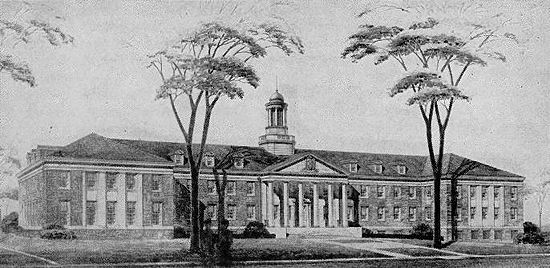
Vintage illustration of the Medical Field Service School, Carlisle Barracks, Pennsylvania
The motto of the Medical Field Service School was: ‘To Conserve Fighting Strength’.
Here follows a list of major Medical Training facilities, in use during WW2:
Camp Barkeley, Abilene, Texas:
Acreage 69,879 – troop capacity 3,192 Officers & 54,493 Enlisted Men. Cp. Barkeley MRTC was activated 1 November 1941 and closed 1 April 1945. The overall training activities lasted from 8 December 1941 to 17 March 1945. (units > 11th Medical Training Regiment and 52d Medical Training Battalion). Cp. Barkeley was also an Armored Division Camp during WW2 and was eventually consolidated with the existing Signal Corps Training Center at Camp Crowder (which was closed 1 April 1944). In line with the planned US Armed Forces expansion and reorganization, and in order to provide more training facilities, a second OCS Medical Administrative School was established at Cp. Barkeley on April 11, 1942 supplementing the current one operating at the Medical Field Service School, Carlisle Barracks, Pennsylvania. The School was to provide an additional number of Commissioned Medical Corps and Medical Administrative Corps Officers required by the expansion of the Army’s Medical Department. The length of all courses was eleven weeks (later increased to twelve), and successful graduates were appointed as Second Lieutenants and either assigned to duty at once with the corresponding arm or service with which they received their training or joined a Replacement Pool. The overall training program allotted 2 weeks for Basic Military Training – 3 weeks for Basic Tactical Training – and 6 weeks for Technical Training. In August of 1943, as Camp Pickett was being closed, MRTC Camp Barkeley was assigned the responsibility for training African-American troops (in 1944, between 1,000 and 1,400 were trained at the camp -ed). By April 1944, the capacity of the Medical Replacement Training Center was increased to 37,150 trainees.
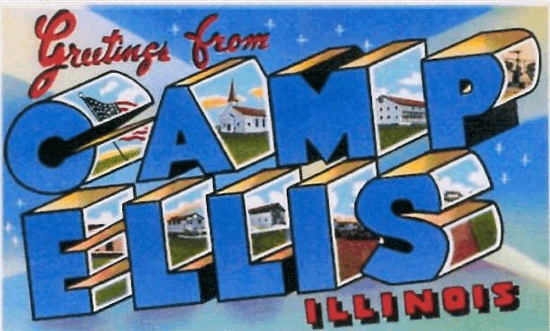
WW2 Postcard of Camp Ellis, Table Grove, Illinois
Camp Ellis, Table Grove, Illinois:
Acreage 17,503 – troop capacity 1,795 Officers & 24,654 Enlisted Men. Cp. Ellis MRTC was activated 1 February 1943 and closed 31 December 1944. The overall training activities lasted from 23 June 1944 to 1 February 1945. (units > 28th, 29th, 30th, 31st, and 32d Medical Training Regiments). Camp Ellis was also an Army Service Forces Training Center (ASFTC) for Corps of Engineers, Quartermaster and Signal Corps personnel.
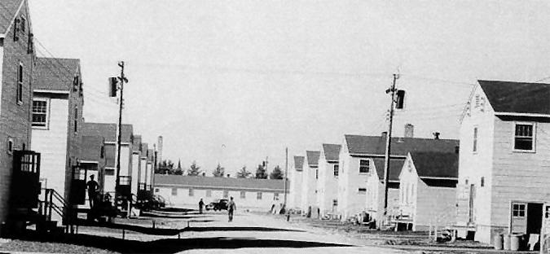
Partial view of Camp Grant, Rockford, Illinois
Camp Grant, Rockford, Illinois:
Acreage 3,349 – troop capacity 453 Officers & 20,836 Enlisted Men. Cp. Grant MRTC was activated 14 March 1941 and closed 15 October 1944. The overall training activities lasted from 15 March 1941 to 30 September 1944. In June 1944 the MRTC activities were transferred to Ft. Lewis, Tacoma, Washington.
Camp Lee, Blackstone, Virginia:
Cp. Lee MRTC was activated 16 January 1941 and closed 19 June 1942. The overall training activities were short, since the MRTC was transferred to Cp. Pickett in June 1942.
Camp Pickett, Blackstone, Virginia:
Acreage 45,867 – troop capacity 2,363 Officers & 41,552 Enlisted Men. Cp. Pickett MRTC was activated 19 June 1942 and closed 31 October 1943. The overall training activities lasted from 20 June 1942 to 30 September 1943. (total number of units > 14 Medical Training Battalions).
Camp Joseph T. Robinson, Little Rock, Arkansas:
Acreage 42,124 – troop capacity 2,596 Officers & 44,077 Enlisted Men. Cp. J.T. Robinson MRTC was activated 15 January 1942 and closed 14 October 1943. The overall training activities lasted from 1 February 1942 to 11 October 1943. (units > 140th Medical Training Battalion, 21st, 22d, 23d Medical Training Regiments).
Carlisle Barracks, Carlisle, Pennsylvania:
Acreage 1,390 – troop capacity 164 Officers & 3,332 Enlisted Men. Carlisle Barracks was activated in 1921. In July 1941 it became home to the Medical Field Service School (i.e. an OCS School for the Medical Administrative Corps). Its mission was to provide Officers and Enlisted personnel trained in medical field service for duty with Medical Detachments of units of the arms and services (i.e. attached medical personnel), and Officers to command units of Medical Battalions, Squadrons, and Regiments which formed an organic part of Divisions, Corps, and field Armies.
Fort Lewis, Tacoma, Washington:
Acreage 90,870 – troop capacity 3,542 Officers & 63,727 Enlisted Men. Ft. Lewis TC was activated 1 June 1944 and closed 1 April 1945. The overall training activities lasted from 25 June 1944 to 20 March 1945. Ft. Lewis became the largest Army Service Forces Training Center in the United States, exclusively training Medical personnel and Engineers. In June 1942 its medical facilities trained an average of 36,000 EM per training cycle, and by June 1943, this increased to 44,349 EM per training cycle.
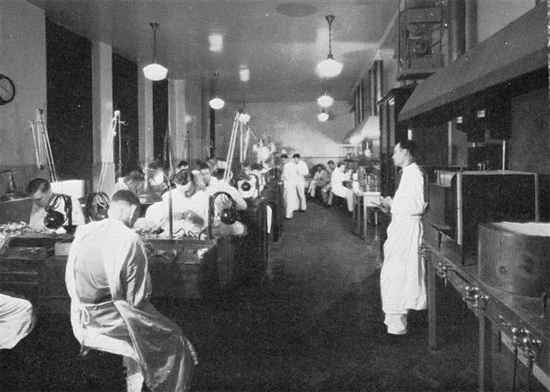
Enlisted Dental Technicians’ Class. Duties of the EM of the Medical Department were varied and technical, ranging from those of ambulance drivers to those of skilled assistants in laboratory, X-ray, dental, and surgical work.
Training of Medical Units for Field Operations
In addition to the training programs peculiar to the Medical Department, medical units participated in practice marches, maneuvers, and such training as conducted by the Armed Services to which they were attached or of which they were an integral part.
Every member of a medical unit received basic military training (such as individual defense – individual protection – dismounted drill – military courtesy), technical training (including ‘special’ training and instruction), tactical training (covering logistical movements – operations – field exercises – functions of medical installations), moreover Officers received additional training for field duty (incorporating administration – training methods – field hygiene – sanitation – first aid – supply – military law – combat principles – field orders – standing operating procedures – map reading & sketching – field fortifications – interpretation of aerial photographs – etc).
In order to meet the demand for trained medical soldiers, common specialists, and commissioned Officers, the capacity of existing MRT Centers was expanded. At the same time, the period of Basic Training for Fillers and Replacements was reduced to 8 weeks, instead of 13 weeks (which still included 2 full weeks of Basic Military Training, 2 weeks for Basic Tactical Training, but only 4 weeks of Technical Training). A new Mobilization Training Program 8-5 (MTP) was published by the War Department 2 January 1942 consisting of a full eight-week period. A revised program was issued 15 November 1942 (which returned to an 11-week cycle), followed by another program published 12 May 1943 (including a revised 12-week training period), and a final MTP 8-5 program which came out 1 August 1943.
Qualities to be developed in training were the same for all members of the US Armed Forces. As such, Medical Department soldiers were to be good soldiers having the same high standard of discipline of: health, strength and endurance; and also of morale, initiative and adaptability. Differences in training were in fact only confined to ‘special’ subjects relating to tactical and technical proficiency.
